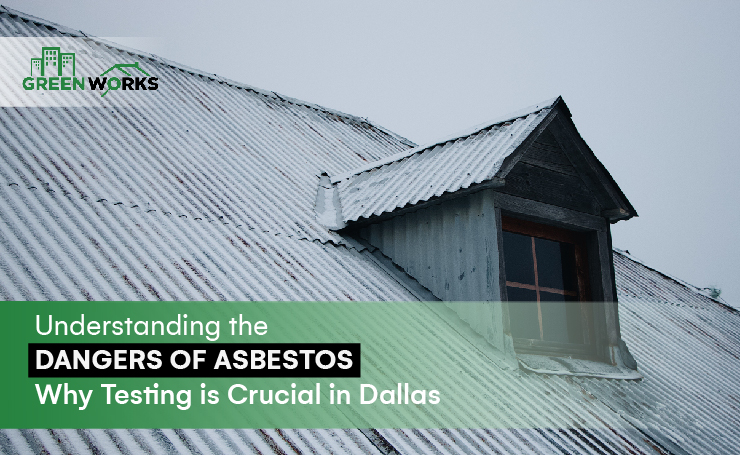Posts

Understanding the Dangers of Asbestos: Why Testing is Crucial in Dallas
Due to its widespread use in the 1950s, 1960s, 1970s, and 1980s, asbestos may exist in many older homes in Dallas. The problem with this is that, despite being widespread in the past, asbestos may cause various health problems, some of which are fatal. As a result, asbestos testing Dallas is exceptionally essential if you want to keep safe.
Asbestos is no longer used in buildings since it is extremely dangerous, even though contemporary technology has improved how we construct buildings for many different reasons, including better materials and more efficient designs.
It is important to get rid of asbestos whenever it is possible. However, precisely what is asbestos, and why is it so dangerous?
What Is Asbestos?
Asbestos is a natural fibrous silicate substance. Although there are six different kinds of asbestos, they all include tiny, fibrous crystals that can be released into the air when disturbed by abrasion or other factors. These tiny fibers, when breathed, can result in serious, debilitating, and even lethal health issues.
The Risks of Asbestos Exposure
Asbestos fibers are easily inhaled and can cling to the lungs, inflaming and scarring the tissue. Lung cancer, mesothelioma, and asbestosis are just a few major health issues resulting from asbestos exposure. These illnesses’ symptoms can take years, even decades, to appear; in some situations, they can even be fatal.
The cancer mesothelioma affects the lung, chest, and abdominal lining. There is no known cure for it, which is brought on by breathing in asbestos fibers. Shortness of breath, chest pain, and weight loss are among mesothelioma symptoms.
Another major health issue linked to asbestos exposure is lung cancer. Asbestos filaments can harm lung tissue, causing cancerous tumors to grow. Chest pain, wheezing, and coughing are some signs of lung cancer.
Chronic lung disease, known as asbestosis, is brought on by prolonged exposure to asbestos fibers. This can result in chest pain, coughing, and shortness of breath. Asbestosis can cause heart failure or even death in extreme situations.
Who Are Most At Risk Because of Asbestos?
The most significant risk of asbestos exposure comes from working around the toxic mineral. Even though asbestos is no longer mined in the United States, blue-collar employment carries an unusually high risk of asbestos exposure. Additionally, exposure to the military, old homes, and schools is risky.
Living next to someone who works with asbestos products puts them at risk for secondhand exposure. Residents who reside close to asbestos-producing plants and those who live among mines still operating can face environmental health concerns.
When Is Asbestos Dangerous?
If you breathe in asbestos fibers, you could get sick. Some claim that certain types of asbestos fibers are less harmful than others. Doctors and scientists are among the many people who disagree. Consider all asbestos hazardous until it has been proven safe.
The presence of asbestos in the air or damage to your lungs cannot be detected. You won’t sneeze or cough when around asbestos. It won’t irritate your skin or throat. Asbestos fibers are released into the air when asbestos-containing materials are damaged, disturbed, or unsafely removed. Crushed asbestos does not produce typical dust. The fibers that are released from asbestos are too small to be felt, tasted, or seen.
Asbestos gets into the environment when it is released into the air. If you enter these environments, you could be exposed to asbestos. The likelihood that asbestos exposure will have a negative impact on health depends on several factors. These factors consist of:
- Dose (how much);
- Duration (how long);
- The route or pathway by which you are exposed (breathing, eating, or drinking); and
- Other chemicals to which you are exposed.
Additionally, certain individual characteristics may also have an effect, such as:
- Age;
- Gender;
- Nutritional status;
- Family traits;
- Lifestyle; and
- Your general state of health.
The Process of Asbestos Testing and Inspection
There are various processes involved in the testing and inspection procedure for asbestos.
Finding probable asbestos sources is the first step. This can include building supplies like roofing materials, textured coatings, floors, and boards. Using a recognized inspection organization to conduct asbestos surveys is strongly advised since the surveyors will have the necessary training, expertise, and authorization, and the company will have a reliable quality management system.
After identifying possible asbestos sources, samples of the construction materials are obtained and sent for bulk analysis to the lab. The material must be examined under a microscope to determine whether asbestos fibers are present.
Another method of testing for asbestos that is used to determine the amount of asbestos fibers in the air is air sampling. Depending on the circumstances, several air tests can be conducted; nevertheless, a laboratory must conduct all asbestos testing Dallas.
What To Do If Asbestos Testing Detects Asbestos?
It can be unsettling to learn that asbestos is present in your home or place of employment. When its fibers become airborne and are inhaled, asbestos, a material previously praised for its ability to withstand fire, poses serious health hazards. If professional asbestos testing Dallas reveals its existence, it’s imperative to act quickly and wisely to protect your health and those around you. Below, we provide extensive guidance on what to do if asbestos testing reveals its presence:
Remain Calm and Limit Exposure
It’s normal to feel worried when asbestos is confirmed to be present. However, it’s important to keep your cool. Reduce the amount of any action, such as drilling, sanding, or demolition work, that can disrupt asbestos fibers. Taking steps to lessen disturbances can help limit additional exposure to asbestos, which becomes dangerous when its fibers are discharged into the air.
Restrict Access
If you find asbestos, then it is essential to restrict the access to the affected area. This stops asbestos fibers from accidentally spreading to other areas of your house or place of employment. Let your family, coworkers, or tenants know about the dangers and the restricted area.
Professional Assessment
Hire the services of an environmental expert with experience with asbestos-related issues or a licensed asbestos abatement professional. These professionals can comprehensively analyze the problem, evaluate the level of asbestos contamination, and suggest the best courses of action for containment or removal.
Develop A Management Plan
Professionals can help you create a management plan customized to your scenario based on the assessment. The asbestos-containing materials may be enclosed, encapsulated, or removed as part of this strategy. The method will vary depending on the state, location, and likelihood of disturbance of the item.
Asbestos Removal or Abatement
Rely on licensed asbestos removal contractors if you think removal is necessary. These experts have the knowledge, equipment, and safety gear necessary to remove asbestos-containing items safely and follow the law, aiming to reduce fiber leakage and ensure proper disposal and the removal process.
Ready to ensure the safety of your living or working space? Contact GreenWorks Inspections today for comprehensive professional asbestos testing Dallas and expert guidance. Your health and peace of mind matter to us. Schedule your inspection now to create a safer environment for yourself and your loved ones. Let’s work together for a healthier tomorrow.




